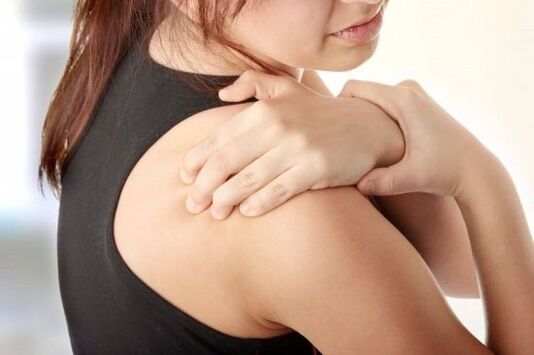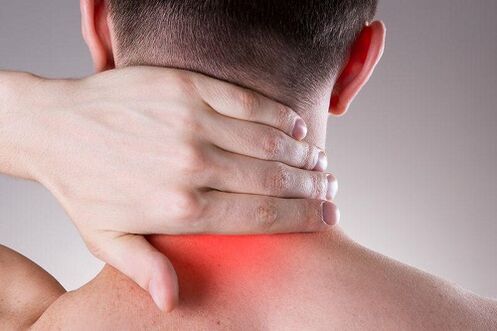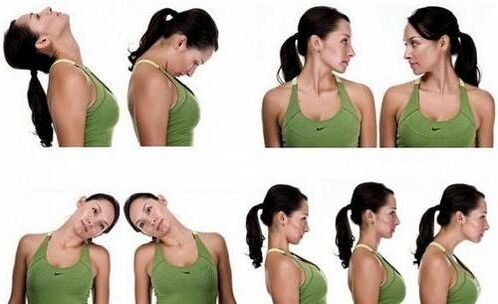Cervical spine osteochondrosis (CS) is one of the most common pathologies of the musculoskeletal system. Doctors are diagnosing this disease more and more often every year, and it is progressing more and more severely. According to statistics, degenerative-dystrophic changes of the upper spine are more common in women, especially in postmenopausal patients. In women, the main symptoms of osteochondrosis of the neck are pain, limited mobility, insufficient cerebral circulation, and this is dangerous not only to health but also to life. To protect yourself from the dangerous consequences of the pathology, you need to start treatment at an early stage. It is important to perform complex therapy, make lifestyle changes to stop the destruction of spinal segments, and prevent serious complications.
Development of disease
The cervical spine is the most vulnerable to various injuries and degenerative changes. This is due to the fact that this segment is the most mobile and the muscles here are weak. The small cervical vertebrae withstand severe stress every day, leading to the gradual destruction of the intervertebral discs. The vertebrae press against each other, so the cartilaginous pads between them lose a lot of fluid, starting to degrade and deform.
In addition, osteochondrosis of the cervical spine develops due to insufficient nutrition of the cartilage tissue. In this area, the spinal canal is narrow and therefore often constricts, causing neurological symptoms.
Pathology in early stage women with difficulty in the back of the head, tingling in the hands, etc. Often, patients confuse the first signs of the disease with overload.
There are a large number of blood vessels and nerve roots in the neck area, and compressed neurological disorders can also occur. It is especially dangerous if a deformed disc or vertebra squeezes the vertebral artery that feeds important parts of the brain. When squeezing the coordination of movements is disturbed, the woman may lose her balance, her vision and hearing deteriorate, and the risk of stroke increases.
Reference. According to statistics, cervical osteochondrosis is most commonly found in patients aged 25-40 years. This is due to the huge decrease in physical activity, sedentary work. Women are diagnosed with the disease more often than men because their vertebrae are more fragile and have thin bone tissue.
Doctors distinguish 4 stages of osteochondrosis SHOP:
- Stage 1 - the intervertebral disc loses some moisture, its height decreases, cracks may appear in the fibrous ring (outer shell). It is a stage of cervical chondrosis that is difficult to identify because it has inexpressible symptoms. The neck gets tired quickly, discomfort, difficulty in the injured area, sometimes there is a slight pain that goes away quickly.
- Stage 2 - cracks increase on the surface of the disc, the nucleus pulposus (the gel-like content of the disc) moves, it can protrude in the damaged areas. This is how the protrusion of the cartilage lining appears, which can compress the spinal cord and its roots. Occasionally, severe pain, weakness, limited movement, numbness of the face, neck, shoulders, or arms may occur.
- Stage 3 - the protrusion breaks through the outer shell of the disc, forming a hernia. The pain becomes more pronounced, neurological disorders are present.
- Stage 4 - the disc is almost completely destroyed, the vertebrae rub against each other, and bone growths (osteophytes) appear at their edges to stabilize the injured segment. The nerve endings, spinal cord, blood vessels were damaged. Adjacent joints begin to damage. Clinical symptoms are pronounced.
The easiest way to stop degenerative-dystrophic changes in the first two stages of SHOP osteochondrosis. In stage 3, the complex treatment helps to stop further destruction of the spine. The last stage cannot be done without surgery.
The reasons
The osteochondrosis SHOP is a complex and lengthy process that most often has several causes. In most cases, the pathology is due to a sedentary lifestyle, malnutrition, and metabolic disorders. Often, the disease is caused by injuries or a natural aging of the body and a weakening of its defenses.
Doctors identify the main causes of osteochondrosis SHOP in women:
- Disruption of metabolic processes.
- Passive lifestyle.
- Genetic predisposition.
- Chronic muscle tension around the neck segment.
- Curvature of posture.
- Lack of fluids and nutrients in the body.
- Prolonged discomfort (neck bent forward and backward).
- Excessive weight.
- He often wears high heels.
- SHOP injuries.
- Lifting heavy objects.
- Autoimmune pathologies.
- Frequent stress, chronic fatigue.
- Hypothermia.
- Infectious diseases.
- The neck is too long or too short and so on.
All of these factors cause malnutrition in the intervertebral discs and lead to their degeneration.
Female cervical osteochondrosis may be caused by pathology of the vertebral artery, which is associated with genetic predisposition, intrauterine disorders, and postpartum trauma. The disease can be a consequence of rheumatism, endocrine disorders, overload of the cervical segment during pregnancy, local overload.
Important. In women, the main cause of osteochondrosis of the cervix is menopause, as well as the changes associated with this period. At this stage, the concentration of progesterone in the body decreases, which is very important for bone tissue. The likelihood of degenerative changes is associated with age-related weakening of the neck muscles and weakening of vertebral support in this area.
Symptoms
In osteochondrosis, a wave-like process is characteristic when the acute period is replaced by remission. Exacerbation can cause infections, injuries, hypothermia, and prolonged neck stress.

In women, the first signs of cervical osteochondrosis are headache, discomfort, and neck difficulty. It is important to differentiate chondrosis pain from migraine or autonomic dysfunction in a timely manner.
Clinical manifestations of osteochondrosis SHOP in women are caused by neurological syndromes:
- Cervical dyscalgia occurs when nerve endings are irritated by fragments of damaged cartilage lining. Then there is a special crackling, pain in the neck, which becomes even more pronounced when the head is moved and after sleep.
- Scalene muscle syndrome becomes a consequence of damage to the vessels and nerves of the brachial plexus and subclavian artery. This syndrome is accompanied by pain from the inner surface of the shoulder to the hand from the injured side. The limb becomes pale, cool, edematous, numb. Neck pain extends to the headrest when the patient turns his head.
- Shoulder-shoulder periarthrosis syndrome - dystrophic changes affect the tendons surrounding the shoulder. Painful sensations from the neck radiate to the shoulder and shoulder girdle. The neck is in a forced position - it tilts to the affected side and the shoulder lowers slightly.
- Vertebral artery syndrome - the blood vessels are compressed by fragments of the damaged plate or osteophytes (depending on the stage of the disease). The patient is dizzy, has headaches, nausea, and sometimes vomiting. The pain is localized in the nape of the neck, crown, and temples.
- Heart - the nerve bundles of the spinal cord are damaged. There is heart pain, arrhythmia. If C3 is damaged, there is pain in half of the neck, the tongue swells, and the patient is unable to chew food normally. If the C4 is damaged, discomfort will appear in the shoulder girdle, collarbone, heart area. By defeating C5, the pain response from the neck extends to the shoulder girdle, the inner surface of the shoulder. C6 irritation manifests as pain from the neck and shoulder blades to the shoulders and extends across the entire arm to the thumb. When the C7 is damaged, the pain syndrome spreads to the back of the shoulder girdle, catching the entire hand, including the index and middle fingers. When C8 is compressed, the pain spreads from the affected area to the elbow and little finger.
In addition, a woman’s emotional sphere may be confused, weaknesses appear, become anxious, touching. Insomnia often occurs, memory and attention are impaired due to regular headaches.
Symptoms of a cerebrovascular accident occur when a woman suddenly throws her head back, tilts it, or does work that puts a strain on her arms and cervical spine, such as digging, painting, painting ceilings, and carrying weights.
Violation of cerebral circulation occurs with dizziness, trembling gait, "flying" in the eyes, tinnitus, weakness, nausea. In some patients, the voice is hoarse, sometimes disappears, and a sore throat appears.
Osteochondrosis during menopause is associated with migraine, increased body sweating in the area between the neck and shoulder girdle. When the vertebral artery is compressed, the work of the cardiovascular system is interrupted.
If the disease lasts for a long time, there is circulatory insufficiency in important centers that perform neuro-endocrine functions. Due to the increased permeability of the vessel walls, atherosclerosis of the cerebral and cardiac arteries develops.

Establishing the diagnosis
If you notice symptoms of osteochondrosis, consult a therapist. After visual inspection, one skilled in the art will refer you to an orthopedist, vertebrologist, or neurologist.
The following methods are used to diagnose cervical osteochondrosis:
- The x-ray allows you to find out that the patient has moved the vertebrae, there are osteophytes on their edges, the distance between the vertebrae has decreased. To do this, the study is conducted in different planes. The doctor takes visuals to detail the characteristic changes.
- Cervical spine CT provides detailed information about abnormal changes in the vertebrae. This method allows the acquisition of volumetric images for a more detailed study, used in severe diagnostic cases.
- MRI is used to accurately assess the condition of the soft areas (nerves, blood vessels, ligaments, muscles) in the affected area.
- Electromyography allows the conduction of a nerve fiber to be monitored.
Doctors may also prescribe Doppler ultrasound (Doppler ultrasound of the large arteries in the brain) to determine the state of blood flow in this area.
Conservative treatment
In the early stages, treatment for SHOP osteochondrosis in women can be done at home. However, the doctor must establish a therapeutic regimen. It is important to understand that this is a long process and is unlikely to fully heal (especially for older women).
The complex treatment includes:
- Taking medications.
- Use of orthopedic devices.
- Physiotherapy.
- Physiotherapy procedures.
- Massage, hand stroke.
- Alternative treatments.
Conservative techniques help to stop pain, inflammation, normalize muscle tone, improve metabolic processes, nutrition of damaged segments of the spine. With timely therapy, pathological changes can be stopped.

Medications to treat cervical osteochondrosis help get rid of inflammation and pain.
In women, the treatment of cervical osteochondrosis is carried out using drugs that help improve the metabolism of cartilage linings between the vertebrae, stop inflammation, pain. The following drugs are used for this purpose:
- NSAIDs. It can help relieve moderate inflammation and pain.
- Analgesics. The pain is relieved.
- Preparations for improving cerebral circulation.
- Muscle relaxers help relieve muscle cramps.
- Chondroprotectors. They help stop the destruction of the plate, improve metabolic processes and speed up healing.
- Magnesium based medicines.
- Nootropics. By stimulating blood circulation, they stimulate the work of the brain and have a mild sedative effect.
Reference. For intense pain that is not relieved by oral medications, therapeutic blockages are used, such as with Novocain or NSAID solutions.
The treatment can be supplemented with anti-inflammatory and analgesic forms in the form of gels, creams and ointments. They will be effective in the remission phase or in combination with oral agents.
The choice of drug combinations is decided by the doctor. The specialist prepares the order of taking the drugs and also determines their dosage. It is important that you follow his recommendations as many of the above medications threaten you with dangerous complications.
In the acute stage of osteochondrosis of SHOP, the woman must give up heavy physical activity. To unload the neck segment, you must wear a special corset (Shants collar) that secures the vertebrae in place. This device is recommended for prolonged sedentary or heavy physical work.
Physiotherapy procedures help relieve pain and improve blood circulation in the injured area:
- Diadynamic therapy.
- Magnetotherapy.
- Electrophoresis.
- Electroanalgesia.
- Ultraviolet irradiation and so on.
The therapeutic effect is manifested approximately after the third session, followed by headache, hearing impairment, blurred vision, dizziness, normalization or disappearance of sleep, and improvement in general condition.
Underwater traction of the cervical segment allows for the widening of the distance between the vertebrae, the release of a nerve or blood vessels from compression, and the restoration of the normal position of the vertebrae.
Massage normalizes muscle tone, reduces lymph fluid flow, causing swelling. After several sessions, blood circulation in the injured area improves.

Therapeutic exercise is one of the most effective ways to treat osteochondrosis in SHOP. Movement therapy allows you to strengthen the weak muscles in the neck, which then take some of the load out of the spine and help stop or slow down the degenerative-dystrophic changes. During the hours, the blood circulation improves, the metabolic processes and the nutrition of the plates speed up, which has a positive effect on their condition.
Women need to train every day. They consist of simple yet effective exercises. The complex consists of twists, tilting of the head in different directions, and neck movements during which the hands are used. These items can be performed at home, but only with your doctor’s permission. Physiotherapy exercises are performed only during the remission phase.
Complex treatment can be supplemented with reflexology (acupuncture), hirudotherapy (leech therapy), swimming, etc.
Surgery
Surgery is prescribed in the final stages of osteochondrosis of the SHOP, accompanied by severe destruction of osteochondral structures. Surgical intervention is also essential if conservative techniques are ineffective or the spinal canal is significantly narrowed.
In the cases described above, anterior cervical discectomy is performed. During the procedure, the doctor fixes the injured segment of the spine and removes the hernia that compresses the spinal nerve. The vertebrae between which the disc was removed then fuse. If necessary, the space between the vertebrae is filled with a synthetic insert (cage).
After 3-5 days, the patient is released home. The rehabilitation period is about 12 weeks. To speed up your recovery, you need to take medication, wear a corset, lead a healthy lifestyle, go to physiotherapy procedures, and finally exercise.
Lifestyle recommendations
To quickly get rid of the unpleasant symptoms of osteochondrosis and stop the degenerative-dystrophic changes in the neck segment, you need to modify your lifestyle. To do this, the patient should follow the following recommendations:
- Walk daily, avoid running, jumping and other explosive activities.
- Heavy objects should not be carried.
- You can’t sit for long, in extreme cases wear corsets and sometimes get in a horizontal position.
- Perform special physical exercises for your back muscles at home.
- Sleep on an orthopedic mattress and a special pillow.
- Adhere to the diet, supplement the diet with foods rich in magnesium, calcium (nuts, dairy products, seafood, legumes), as well as vegetable fiber, chondroitin (jelly meat, jelly). He refuses fatty, fried, too salty foods and alcohol. Your doctor will advise you on dietary rules in more detail. But it must be correct.
Hypothermia is not allowed, warming up will be beneficial in the absence of an inflammatory process.
Complications
In the absence of timely treatment of cervical osteochondrosis, a woman may experience the following pathological consequences:
- The probability of a protrusion that turns into a hernia over time. The bulge compresses the spinal cord as well as the nerves, causing neurological damage.
- Osteophytes appear when the disc is severely damaged; they irritate the nerves and blood vessels of the spine.
- In advanced cases, severe weakening or incomplete paralysis of the neck muscles is possible, and then the head involuntarily hangs to the side or forward.
- Compression of vertebral arteries, impaired blood circulation in the affected area. This condition can cause neuralgia (pain along the nerve), hearing and vision loss.
- Hand paralysis (incomplete or complete).
- Stroke.
If a woman deals with this issue in the early stages of osteochondrosis SHOP, she will be able to prevent the above conditions.
Preventive measures
Ideally, even during the period of intrauterine development, it should be involved in the prevention of SHOP osteochondrosis. The expectant mother should exclude factors that negatively affect fetal development: infections, oxygen starvation, poisoning. If a birth injury has occurred, the newborn should be treated.
To reduce the likelihood of developing osteochondrosis SHOP, a woman should follow these recommendations:
- Fill the spine evenly, for example, carry the load in both hands, or turn right and then left.
- Do not lift too much weight yourself.
- Try to avoid neck injuries, hypothermia.
- If you work on garden plots, take a break every 1, 5 hours, go to rest for 20 minutes.
- Choose shoes with padded soles that absorb shocks while running or jumping.
- If you sit for a long time, use a high-backed chair with a headrest or wear a corset.
It is also important to eat properly, control body weight, avoid stress, take vitamin supplements for medical reasons, and treat pathologies that can cause osteochondrosis in a timely manner. In the remission phase, it is recommended to visit sanatoriums to go through a course of treatment.
The most important
As can be seen, cervical spine osteochondrosis is more common in women than in men because the vertebrae are more fragile and the bone tissue is thin. The patient's pathology is particularly sensitive in the postmenopausal period. The disease manifests itself in pain, neurological disorders and dangerous symptoms of cerebrovascular accidents. It is recommended to start treatment at an early stage to avoid dangerous complications of osteochondrosis. To do this, the woman must take medication, change her lifestyle, participate in physiotherapy procedures, massage, and perform physiotherapy. Surgical treatment is recommended only in advanced cases. To prevent pathology, you need to monitor moderate physical activity, treat injuries and diseases that can provoke osteochondrosis in a timely manner.













































